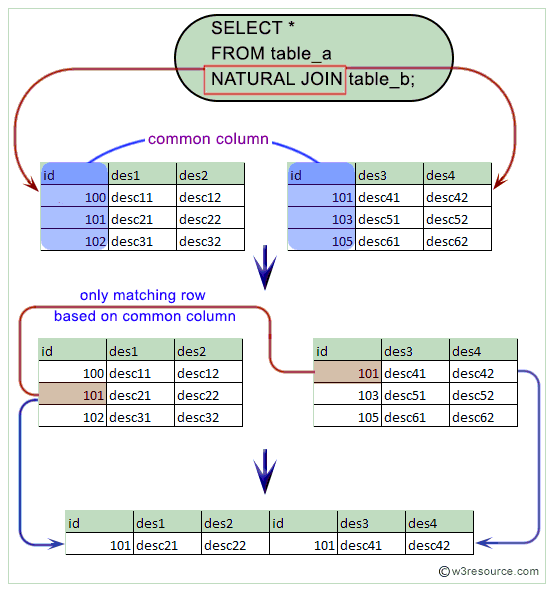
- #SQLITE INNER JOIN EXAMPLE HOW TO#
- #SQLITE INNER JOIN EXAMPLE FULL#
- #SQLITE INNER JOIN EXAMPLE CODE#
#SQLITE INNER JOIN EXAMPLE HOW TO#
In this tutorial, we have shown you how to use the SQLite self-join technique to join a table to itself.
#SQLITE INNER JOIN EXAMPLE CODE#
INNER JOIN employees e2 ON e2.city = e1.cityĪND (e1.firstname e2.firstname AND e1.lastname e2.lastname)Į1.city Code language: SQL (Structured Query Language) ( sql ) You can use the self-join technique to find the employees located in the same city as the following query: SELECT DISTINCTĮ1.firstName || ' ' || e1.lastname AS fullname In case you want to query the CEO who does not report to anyone, you need to change the INNER JOIN clause to LEFT JOIN clause in the query above.Īndrew Adams is the CEO because he does not report anyone.
#SQLITE INNER JOIN EXAMPLE FULL#
In the example, we use the concatenation operator to from the full names of the employees by concatenating the first name, space, and last name. Note that the concatenation operator || concatenates multiple strings into a single string. The employees table has two roles: employees and managers.īecause we used the INNER JOIN clause to join the employees table to itself, the result set does not have the row whose manager column contains a NULL value. The statement used the INNER JOIN clause to join the employees to itself.

ORDER BY manager Code language: SQL (Structured Query Language) ( sql ) INNER JOIN employees m ON m.employeeid = e.reportsto

To get the information on who is the direct report of whom, you use the following statement: SELECT m.firstname || ' ' || m.lastname AS 'Manager',Į.firstname || ' ' || e.lastname AS 'Direct report' FROM employees e In case an employee does not report to anyone, the ReportsTo column is NULL. If an employee reports to a manager, the value of the ReportsTo column of the employee’s row is equal to the value of the EmployeeId column of the manager’s row. The ReportsTo column specifies the reporting relationship between employees. The employees table stores not only employee data but also organizational data. We will use the employees table in the sample database for demonstration. For further information about reading a schema, see the article Crow’s Foot Notation on the Vertabelo blog. You often use self-join to query parents/child relationship stored in a table or to obtain running totals. For example, there’s a reference between the student and studentcourse tables each student can be linked to multiple rows in the studentcourse table. Only one table is involved in the self-join. The self-join compares values of the same or different columns in the same table. You use self-join to create a result set that joins the rows with the other rows within the same table.īecause you cannot refer to the same table more than one in a query, you need to use a table alias to assign the table a different name when you use self-join. The self-join is a special kind of joins that allow you to join a table to itself using either LEFT JOIN or INNER JOIN clause. Note that you should be familiar with INNER JOIN and LEFT JOIN clauses before going forward with this tutorial. And in the albums table, the AlbumId is the primary key.Summary: in this tutorial, you will learn about a special type of join called SQLite self-join that allows you to join table to itself. In the tracks table, the AlbumId column is a foreign key. The tracks table links to the albums table via AlbumId column. Let’s take a look at the tracks and albums tables in the sample database. The following diagram illustrates the INNER JOIN clause: SQLite INNER JOIN examples

Only the rows in the A table: (a1,1), (a3,3) have the corresponding rows in the B table (b1,1), (b2,3) are included in the result set. This logic is applied if you join more than 2 tables. In other words, the INNER JOIN clause returns rows from the A table that has the corresponding row in B table. If the value of the f column in the A table equals the value of the f column in the B table, it combines data from a1, a2, b1, b2, columns and includes this row in the result set. For each row in the A table, the INNER JOIN clause compares the value of the f column with the value of the f column in the B table.


 0 kommentar(er)
0 kommentar(er)
